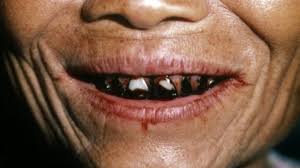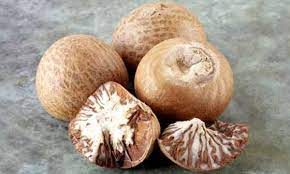
 The betel nut is the fibrous seed of the areca palm (Areca nut).
The betel nut is the fibrous seed of the areca palm (Areca nut).
This nut is chewed but not swallowed.
It is usually placed in the buccal cavity where the nicotinic acid-based alkaloid arecoline is absorbed transorally.
The drug is used as a substance for its stimulant affect that enhances alertness and in some individuals produces a mild euphoria.
The nut is often consumed with tobacco, slaked lime, and a plant leaf.
In 2002 there were an estimated 600 million betel nut users, making the betel nut the fourth most commonly consumed drug after caffeine, nicotine, and alcohol.
It is characterized as an oral carcinogen.
It promotes non-malignant odontogenic disease , and is associated with a number of systemic conditions and adverse pregnancy outcomes.
Bettle nut consumption and the incidence of oral cancer have increased throughout Asia/Pacific regions in recent decades.
The areca nut, the seed of the areca palm grows in much of the tropical Pacific (Melanesia and Micronesia), South Asia, Southeast Asia, and parts of east Africa.
Arecoline is the primary psychoactive ingredient in the betel nut, and it contribute to histologic changes in the oral mucosa.
The betel nut isba major risk factor for squamous cell carcinomas of the mouth and esophagus.
The areca nut is actually ab seed of a fruit categorized as a berry that is available in dried, cured, and fresh forms.
It is usually chewed , as slices of the nut are wrapped in a betel leaf along with calcium hydroxide (slaked lime) and may or other spices for extra flavoring.
Betel nuts/betel leaf effects are a mild stimulant, with a warming sensation in the body and slightly heightened alertness.
The areca nut contains the tannins arecatannin, gallic acid, oil gum, terpineol, lignin, saline substances, and three main alkaloids—arecoline, arecaidine, and guvacine.
All of the above have vasoconstricting properties.
The betel leaf chewed along with the nut contains eugenol, another vasoconstrictor, and tobacco leaf is often added, adding the effect of nicotine.
Areca nuts are chewed along with betel leaf, and also also used in the preparation of Ayurvedic and traditional Chinese medicines, as constituent in some dentifrices.
Other traditional uses include the removal of tapeworms and other intestinal parasites, and against bad breath.
Systemic effects: including the brain, heart, lungs, gastrointestinal tract and reproductive organs.
It causes or aggravates pre-existing neuronal injury, myocardial infarction, cardiac arrhythmias, hepatotoxicity, asthma, central obesity, type II diabetes, hyperlipidemia, and metabolic syndrome.
Areca nuts affects the endocrine system, leading to hypothyroidism, prostate hyperplasia and infertility.
Alters the immune system leading to suppression of T-cell activity and decreased release of cytokines.
It has harmful effects on the fetus when used during pregnancy.
Habitual chewers of betel leaf and areca nut are at increased risk of developing a cancers of the mouth and esophagus.
It causes of oral submucous fibrosis, a premalignant lesion which frequently progresses to oral lesions and squamous cell carcinoma.
The acute effects of chewing betel nuts include: asthma exacerbation, hypertension, and tachycardia.
With regular use: higher risk of cancers of the liver, mouth, esophagus, stomach, prostate, cervix, and lung, and increased the risk of developing type 2 diabetes.
It has been associated with deterioration of psychosis in people with preexisting psychiatric disorders.
Consumption of betel nuts is also tied to chronic kidney disease in men as well as reports of milk-alkali syndrome.
Consumption of betel quid or areca nut by hundreds of millions of people worldwide is a neglected global public health emergency.
Chewing areca nut and betel leaf formulations during pregnancy significantly increases adverse outcomes for the baby: higher incidences of preterm birth and low birth weight and height.
These effects may be a consequence of the arecoline that is found in areca nuts.
The major alkaloid in betel nut is arecoline.
Chewing betelnut produces a red residue, which is spat out.
India is the largest consumer of areca nut, and the rest of the Indian subcontinent, the preparation of nut with or without betel leaf is commonly referred to as paan.
It is available practically everywhere and is sold in ready-to-chew pouches called pan masala or supari, which is the dried form of the Areca Nut, as a mixture of many flavours whose primary base is dried areca nut crushed into small pieces.
Oral cancer has been identified as a leading cause of death in professions with high betel nut-chewing rates.
In the United States, areca nut is not a controlled or specially taxed substance and may be found in some Asian grocery stores.
